Rodin was a Hacker
Sculpture, journalism, performance, drawing, installation, painting, and Web design converge in the photographs and photo-inspired pieces of “Native Sons,” an exhibit of six artists working in Texas. Native Texan Jennifer Ward and New Jersey transplant Vinod Hopson curated this show, the second “Talent in Texas” exhibition mounted by Fotofest and held at Fotofest’s Houston headquarters. (1113 Vine Street; through November 19.)
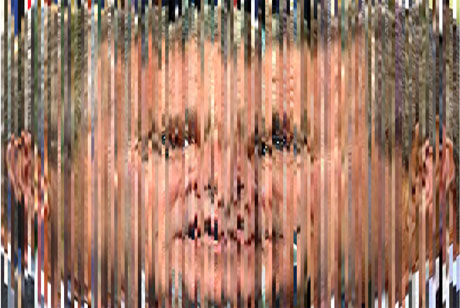
Young-min Kang
The Wizard of Oz once boomed in exasperation, “Pay no attention to the man behind the curtain!” But in Young-Min Kang’s stunning art installation, “George,” the Great Oz is the curtain. In the center gallery at Fotofest, an immense, bobble-eyed image of George W. Bush hangs from the ceiling. The piece assembles 140 color strips, slices from 140 photos of the president that Kang found on the Internet. The artist blew up each sliver up 12 feet tall and has suspended them like vertical shutters. Each photographic strip drops to the floor at a slightly different angle, as if the big screen on high at the Republican National Convention were momentarily on the blink.
Pictured above: “George,” 2004 by Young-Min Kang
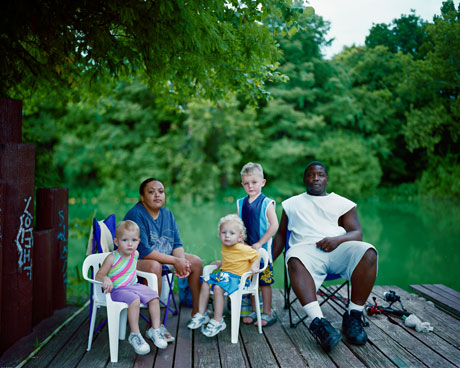
Dave Woody
Woody’s most affecting pictures are of people in lush landscapes, strangers he encounters as they fish along Austin’s Town Lake or wade at Dripping Springs. His subjects all have a sad dignity. Their expressions, Woody says, emerge in the slow process his large format camera requires. These aren’t snapshots. In low light, it may take him 10 minutes to capture an image. In that time, he says, his subjects change. “The initial ‘cheese’ moment gets lost. People relax and become a little more interior.” Nestled in green, idyllic worlds, Woody’s subjects look out like royalty in Van Dyke’s portraits: self-possessed and grave.
Pictured above: “Town Lake,” 2004 by Dave Woody
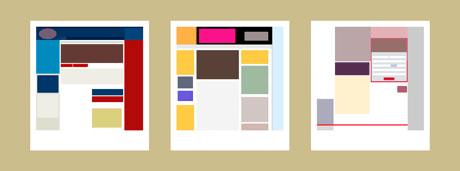
Brian Piana
Having worked up Web pages for companies like Marathon Oil Corp. and Schlumberger Ltd., Brian Piana now has X-ray vision. He sees the formal strategies (and underlying computer codes) that turn Diet Coke or Kinky Friedman into “product”—an identifiable pattern of colors and shapes. His art captures pages off the Internet, strips away text and images, and shows us the building blocks of branding. A sleuth with the aesthetic of Mondrian, he’s decomposed Web sites of many kinds: bureaucratic (Texas Department of Corrections), personal (MySpace.com), commercial (Coca Cola), political (Tom DeLay).
Pictured above: “Ladies and Gentlemen, Your Candidates for Governor,” 2006 by Brian Piana


Chuy Benitez
In panoramic photos reminiscent of the Mexican muralists, Chuy Benitez’s new works are cram-packed with faces, goods, headlines, and history. By digitally stitching together six or seven still shots of a scene, he shows how the past and present overlap. All at once, here are kitsch, news, and piety.
Pictured above: “Mariachis Sangre Joven, Fiesta on Wayside, Houston, TX,” 2006 and “Charros, Fiestas Patrias, Houston,” 2005 by Chuy Benitez
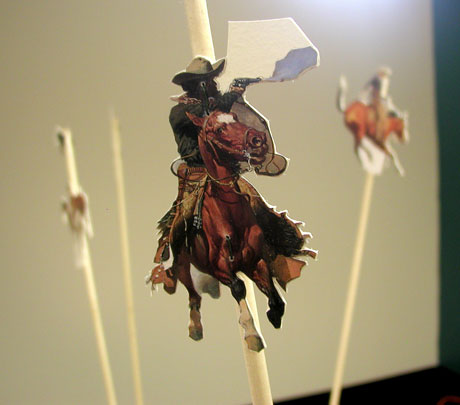
Max Kazemzadeh
Max Kazemzadeh grew up in Duncanville outside Dallas; his father’s family emigrated from Iran in the 1960s. After studying and teaching in New York, he returned to Denton in 2003 to build an electronic media arts program at the University of North Texas.
His “Controlling the Wild West” is an attack—or a joke, at least—on Texas myths and technological proficiency. An assemblage of raw wooden slats, paper cutouts of Frederick Remington’s cowboys and Indians, metal clamps, dowel rods, and wire, the piece squeaks and grinds: a shabby toy. Thanks to several small light sensors, when you approach, it grows excited, clacking and sawing, faster and faster.
“I don’t want to make something enjoyable,” Kazemzadeh says. “It’s not so much about creating content.” Instead, he sees himself working in the tradition of other modernists and postmodernists, stripping away our anchorages to show the habits of creation and perception underneath. “Rodin was a hacker,” Kazemzadeh says, and recalls how the sculptor boldly left his thumbprint in a work of clay.
Pictured above: “Controlling the Wild West,” 2006 by Max Kazemzadeh
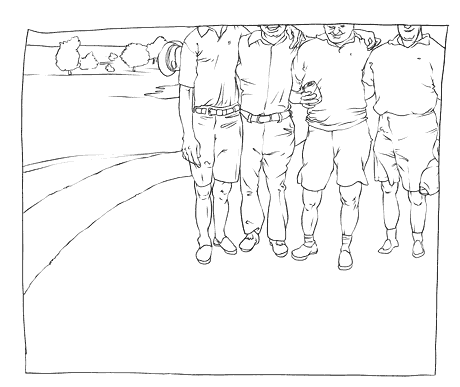
Sterling Allen
A bunch of girls chug-a-lug in unison around a kitchen table; a fat man sleeps with his mouth open, keys and cell phone stashed by the bed. “You can’t make this kind of stuff up,” Sterling Allen says. And he didn’t. His drawings are lifted from photographic rejects, pictures he’s scavenged at yard sales or picked out of the trash at the Eckerds and CVC photo labs where he used to work.
Allen is a 21st century surrealist. To his own experiment with “found art,” he adds the edginess of pilfering and has amped up the voyeurism—making it tactile by actually copying personal snapshots by hand.
Intrigued by the cropped off limbs, closed eyes, bungled angles, Sterling says he tries “to keep all that goof,” rather than editing it out. Nowadays shots like these would be zapped with a few taps of the “delete” button. Allen retrieves orphans of the Kodak age and makes them stranger with his own confidant graphite line. As a teenager in San Antonio, he worked four summers cranking out caricatures at Fiesta Texas. Except there’s so much comedy and affection in his drawings, they might be revenge.
Pictured above: “Untitled (Golf Buddies),” 2006 by Sterling Allen.
Julie Ardery is a writer living in Austin.


